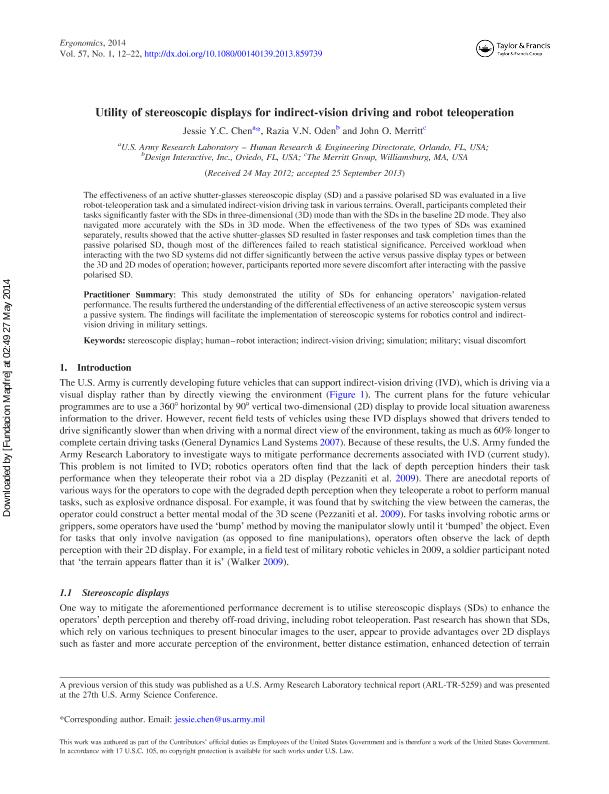Utility of stereoscopic displays for indirect-vision driving and robot teleoperation

Contenido multimedia no disponible por derechos de autor o por acceso restringido. Contacte con la institución para más información.
| Tag | 1 | 2 | Value |
|---|---|---|---|
| LDR | 00000cab a2200000 4500 | ||
| 001 | MAP20140018994 | ||
| 003 | MAP | ||
| 005 | 20140530130416.0 | ||
| 008 | 140527e20140106esp|||p |0|||b|spa d | ||
| 040 | $aMAP$bspa$dMAP | ||
| 084 | $a875 | ||
| 100 | $0MAPA20100047248$aChen, Jessie Y.C. | ||
| 245 | 1 | 0 | $aUtility of stereoscopic displays for indirect-vision driving and robot teleoperation$cJessie Y.C. Chen, Razia V.N. Oden, John O. Merritt |
| 520 | $aThe effectiveness of an active shutter-glasses stereoscopic display (SD) and a passive polarised SD was evaluated in a live robot-teleoperation task and a simulated indirect-vision driving task in various terrains. Overall, participants completed their tasks significantly faster with the SDs in three-dimensional (3D) mode than with the SDs in the baseline 2D mode. They also navigated more accurately with the SDs in 3D mode. When the effectiveness of the two types of SDs was examined separately, results showed that the active shutter-glasses SD resulted in faster responses and task completion times than the passive polarised SD, though most of the differences failed to reach statistical significance. Perceived workload when interacting with the two SD systems did not differ significantly between the active versus passive display types or between the 3D and 2D modes of operation; however, participants reported more severe discomfort after interacting with the passive polarised SD. | ||
| 773 | 0 | $wMAP20100019818$tErgonomics : the international journal of research and practice in human factors and ergonomics$dOxon [United Kingdom] : Taylor & Francis, 2010-$x0014-0139$g06/01/2014 Volumen 57 Número 1 - enero 2014 |

